#Neter
Text





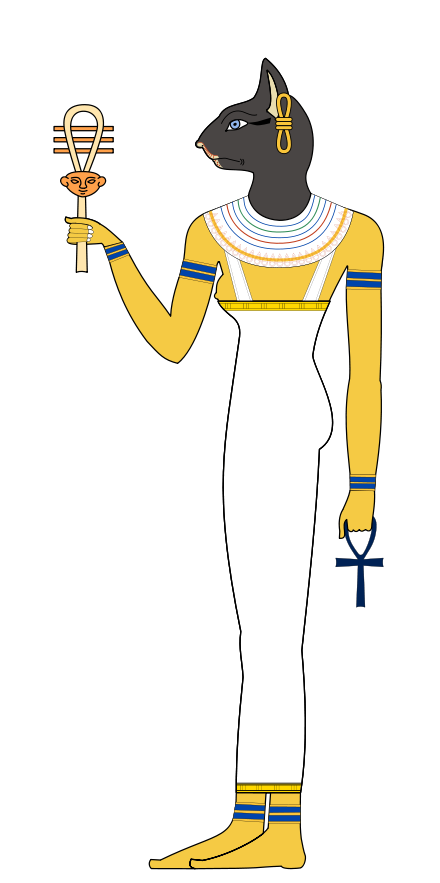
Bastet
Other names:Bast
Major cult center:Bubastis
Symbol:cat, lioness, ointment jar, sistrum, solar disk
Parents:Ra and Isis
Siblings:Horus and Anhur (half-brothers)
Consort:Ptah
Offspring:Maahes
Connection to other gods:Sekhmet, Hathor, Rāt, Tem, Artemis
Celebrations
Bubastis celebrations of Bastet 'Feast of drunkenness'
Bubasteia was celebrated by intoxication,music, debauchery, children would be born without fathers on this day.
Bastet was a goddess of ancient Egyptian religion, worshipped as early as the Second Dynasty (2890 BCE). Her name also is rendered as B'sst, Baast, Ubaste, and Baset. In ancient Greek religion, she was known as Ailuros (Koinē Greek: αἴλουρος "cat").
Bastet was worshipped in Bubastis in Lower Egypt, originally as a lioness goddess, a role shared by other deities such as Sekhmet. Eventually Bastet and Sekhmet were characterized as two aspects of the same goddess, with Sekhmet representing the powerful warrior and protector aspect and Bastet, who increasingly was depicted as a cat, representing a gentler aspect
Role In Ancient Egypt
Bastet was originally a fierce lioness warrior goddess of the sun worshipped throughout most of ancient Egyptian history, but later she became the cat goddess that is familiar today. She then was depicted as the daughter of Ra and Isis, and the consort of Ptah, with whom she had a son Maahes.
As protector of Lower Egypt, she was seen as defender of the king, and consequently of the sun god, Ra. Along with other deities such as Hathor, Sekhmet, and Isis, Bastet was associated with the Eye of Ra.She has been depicted as fighting the serpent named Apep, an enemy of Ra. In addition to her solar connections, sometimes she was called "eye of the moon".
Bastet was also a goddess of pregnancy and childbirth, possibly because of the fertility of the domestic cat.
Images of Bastet were often created from alabaster. The goddess was sometimes depicted holding a ceremonial sistrum in one hand and an aegis in the other—the aegis usually resembling a collar or gorget, embellished with a lioness head.
Bastet was also depicted as the goddess of protection against contagious diseases and malicious spirits.
History
Bastet first appears in the third millennium BCE, where she is depicted as either a fierce lioness or a woman with the head of a lioness.Two thousand years later, during the Third Intermediate Period of Egypt (c. 1070–712 BC), Bastet began to be depicted as a domestic cat or a cat-headed woman.
Scribes of the New Kingdom and later eras began referring to her with an additional feminine suffix, as Bastet. The name change is thought to have been added to emphasize pronunciation of the ending t sound, often left silent.
Cats in ancient Egypt were highly revered, partly due to their ability to combat vermin such as mice, rats (which threatened key food supplies), and snakes—especially cobras. Cats of royalty were, in some instances, known to be dressed in golden jewelry and were allowed to eat from the plates of their owners. Dennis C. Turner and Patrick Bateson estimate that during the Twenty-second Dynasty (c. 945–715 BC), Bastet worship changed from being a lioness deity into being predominantly a major cat deity.Because domestic cats tend to be tender and protective of their offspring, Bastet was also regarded as a good mother and sometimes was depicted with numerous kittens.
The native Egyptian rulers were replaced by Greeks during an occupation of Ancient Egypt in the Ptolemaic Dynasty that lasted almost 300 years. The Greeks sometimes equated Bastet with one of their goddesses, Artemis
Festival
Herodotus also relates that of the many solemn festivals held in Egypt, the most important and most popular one was that celebrated in Bubastis in honor of this goddess.Each year on the day of her festival, the town was said to have attracted some 700,000 visitors, both men and women (but not children), who arrived in numerous crowded ships. The women engaged in music, song, and dance on their way to the place. Great sacrifices were made and prodigious amounts of wine were drunk—more than was the case throughout the year.This accords well with Egyptian sources that prescribe that lioness goddesses are to be appeased with the "feasts of drunkenness".A festival of Bastet was known to be celebrated during the New Kingdom at Bubastis. The block statue from the eighteenth dynasty (c. 1380 BC) of Nefer-ka, the wab-priest of Sekhmet,provides written evidence for this. The inscription suggests that the king, Amenhotep III, was present at the event and had great offerings made to the deity.
──────⊰In Workings⊱──────
*Please know basic protections and energy work before attempting any deity work.*
*It is important to note that everyone's experiences are different and will work with spirits for different reasons. Some people may like a spirit while others will not and that's okay. Ask these spirits what they will work with you on as well as ask them if they can help you with whatever it is you need.*
Ideas for honoring or working with/worshipping Bastet
Altar
Create an altar/sacred space for your rituals and giving offerings for Bastet. Items may include
⬩An altar cloth
⬩Black or yellow candles (you can use any color)
⬩Cup or chalice
⬩Incense and an incense burner
⬩Offering bowl
⬩Statue of Bastet, cat or lion
For more information on basic deity work and altar setups check out the deity work post.
Offering items:Bread, Catnip, Fish, Frankincense, Meats, Myrrh, Perfume bottle, Sistrum, Water
Rituals
⬩Fertility rites and rituals
⬩Protection
⬩Motherhood
⬩You can ask her what she can help you with⬩
𓃠𓃠𓃠𓃠𓃠𓃠𓃠𓃠𓃠𓃠𓃠𓃠𓃠𓃠𓃠𓃠𓃠𓃠𓃠𓃠

For more content relating to other practices/religions or pantheons follow my main blog for updates or ask me anything
If you have any more questions or wish to join a community feel free to join my 18+ discord server
Ask me anything on my blog
#occult#witchcraft#witchblr#deity#neter#neteru#netjer#kemetic#kemetism#Kemetic gods#kemetic pagan#kemetic witch#kemetic paganism#kemetic polytheism#netjeru#spirit#spirits#kemetblr#occultblr#paganism#pagan#witch#Bastet#Bast#neterism
44 notes
·
View notes
Text
How to set up an altar
Are you ready to set up your altar? Whether you follow all of the Netjeru, multiple, singular, or none this will work for you.
First, clear off a space for your altar to be set up. I would recommend burning a candle or incense whilst you are doing this- something that brings you happiness and helps you clear your mind. Lavender or eucalyptus would work. However, that step isn’t necessary because it’s recommended that you first use smoke cleansing to clear your palette before you start setting up. Lavender, pine, mint, eucalyptus, cedar, frankincense and myrrh all have cleansing properties to them. If you are unable to use smoke to help, wiping it down with natural oils would also work- pine sol would be great for this.
Next, set it up how you want. If you want to put down an altar cloth, go ahead and lay that down now. Candles or an incense holder would work on top of this surface too. You can add in a burning dish as well, to burn any offerings you may give or any messages to those who you want to give one too. Along with any offering plate or a libation vessel you wish to use.
If you’re following all of the gods or none of them but still want an altar- I would set up imagery of the core principle of the religion- in this case, as a kemetic pagan, I would set up something to honor *maat*. If you’re honoring just your ancestors, put up an image of them.
Lay on the items that you’ve given to whoever, as an offering, and place them around the altar as you wish. This may include imagery, crystals, stuffed animals, divination tools, jewelry, and any other non-perishable item.
For food offerings, I would, personally, leave it on an offering plate that I have dedicated solely to them; however, this isn’t feasible for everybody so it’s not mandatory. As a kemetic pagan, you may leave your food on your altar, say a prayer or say graditute to the Neter, and, depending on what type of food you’re offering, you may consume it immediately or leave it there over night.
After you have finished setting up your altar, approach it with the intent of it becoming a place of protection, of love, of a safe space. Approach your altar with respect, ask whomever you are speaking to, to guide you and protect you, to provide you with infinite wisdom and resources. Use your manners and say thank you after asking them to give you a space that is safe to approach for rituals, for offerings, for talking.
7 notes
·
View notes
Photo

Afro Culture (My Culture)
@woobosco
#woods#woodstock#woo#Art World#wonderful#mature woman#nature#neter#woo bosco#woo gospel#woo life#woo tribal#wooski#african#african american#afrocentric#afro#afrofuturism#afrikaans#afrohair#Afro Culture#Afro Centric#afro curls#afro cuban#afro love#afro hippie#afro hippy#hippie#hippy#black hippie
10 notes
·
View notes
Text
Ancient Egypt; "Neteru"—The Divine Energies
"The cycle of creation is caused and maintained by divine forces or energies. These energies like the perpetual cycle of creation go through a process of transformation from birth-life-aging-dying-death to rebirth. We, as human beings, have similar life forces that change throughout our lifetime. Our human bodies consist of numerous cycles that govern our life existence. All forces die out when we die.
The Egyptians called these divine forces neteru. The main theme of the universe is its cyclical nature. The NeTeRu are the forces of NaTuRe, which make the world go around—so to speak. To simply call them gods and goddesses gives a false impression.
The Divine energy that manifests itself in the creation cycle is defined by its constituent energy aspects, which were called neteru by the Ancient Egyptians. In order for creation to exist and to be maintained, this divine energy must be thought of in terms of male and female principles.
Therefore, Ancient Egyptians expressed the cosmic energy forces in the terms of netert (female principle) and neter (male principle).
The Egyptian word ‘neter’ (or nature or ‘netjer’) means a power that is able to generate life and to maintain it when generated. As all parts of creation go through the cycle of birth-life-death-rebirth, so do the driving energies, during the stages of this cycle. It is therefore that the Ancient Egyptian neteru, being divine energies, went (and continue to go) through the same cycle of birth-growth-death and renewal. Such understanding was common to all, as noted by Plutarch; that the multitude forces of nature (known as neteru) are born or created, subject to continuous changes, age and die, and are reborn."
Egyptian Wisdom Center
#ancient egypt#ancient wisdom#neteru#netert#female principle#neter#male principle#divine feminine#divine masculine#birth#creation#rebirth#reincarnation#cycles#divine energies#humanity#nature#cosmos#source
1 note
·
View note
Text
Considerazioni sulla tradizione magica egiziana
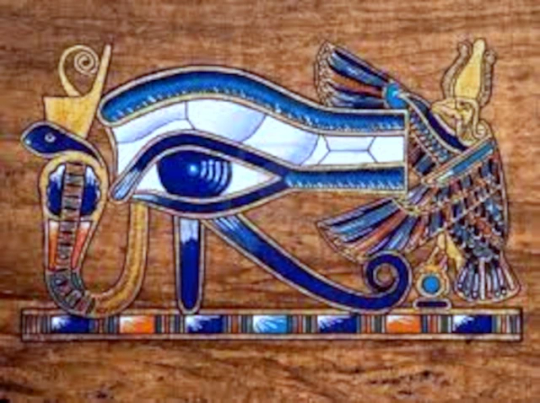
In questo articolo ci interesseremo degli elementi principali della tradizione magica egiziana .
Al contrario di quanto si pensava nel mondo classico i testi scoperti nell’era moderna dimostrano che la magia egiziana era un’arte estremamente evoluta.
Nella religione egizia Heka era la deificazione della magia essendo il suo nome abitualmente tradotto con magia o forza soprannaturale.
Secondo i testi egiziani Heka esisteva “ prima della nascita della dualità” .
Il termine Heka è usato anche per la pratica dei riti magici .
Heka nella religione egiziana era colui che attivava il Ka , l’aspetto dell’anima che incorporava la personalità.
Gli egiziani erano convinti che la magia agisse attivando la potenza dell’anima .
Heka agiva insieme ad Hu il principio della parola divina sia nel mondo mortale che in quello divino .
Heka essendo uno che attivava il Ka veniva anche definito figlio di Atum creatore delle cose in generale .
La magia per gli antichi egiziani permeava ogni cosa nella creazione e come tale tutte le cose nella creazione possedevano Heka in una certa misura .
Ogni antico egizio a suo modo era un mago e prendeva parte al potere che gli dei avevano dato agli uomini di agire sul mondo reale.
La comprensione dell’Heka dava la possibilità al sacerdote / mago di compiere i riti magici .
Di conseguenza egli più Heka acquisiva maggiore era la capacità di compiere riti magici.
La magia in Egitto a differenza di quella occidentale non veniva divisa in magia nera e magia bianca ma in una “magia inferiore” e in una “ magia superiore”.
La magia inferiore era la magia del mondo fisico della salute , del danaro e della fortuna mentre la “magia superiore” era associata allo spirito.
Per gli antichi egizi la magia era stata donata dalla divinità agli uomini per respingere le avversità.
Di conseguenza essa era un modo per combattere in maniera efficace il destino avverso.
Diversi erano i tipi di magia utilizzati dagli antichi egizi : magia scritta ,magia delle parole , magia simpatica ,magia con amuleti.
Per quanto riguarda la magia scritta dobbiamo dire che essa era molto utilizzata sulle pergamene e i testi sacri e sulle mura delle case.
A sua volta la magia delle parole era basata sul principio secondo il quale la parola nell’antico Egitto era considerata sacra e creatrice.
Infatti nel Libro dei Morti stava scritto : “ che i tuoi pensieri siano i grandi incantesimi magici che escono dalla tua bocca “.
Nell’antico Egitto la formula magica era l’arma più potente del mago .
Di conseguenza la sua corretta pronuncia era essenziale per l’efficacia del rito magico.
Non dobbiamo dimenticare che secondo gli antichi egiziani l’intero universo era costituito da vibrazioni cosicchè le vibrazioni davano luogo ad effetti .
Esse potevano assumere la modalità del comando o della preghiera al Neter .
Esso era per gli egiziani un aspetto di Dio.
In tal senso l’Heka di cui abbiamo parlato in precedenza era l’energia latente in certe parole di potenza e in certi gesti rituali .
I sacerdoti egiziani erano pertanto considerati potentissimi signori della Parola .
La magia del nome era di fondamentale importanza nell’antico Egitto dal momento che era considerata di fondamentale importanza conoscere il nome segreto dell’essere .
Infatti il nome segreto racchiudeva l’essenza dell’essere cosicché conoscerlo significava averne il dominio .
Per quanto riguarda la magia simpatica dobbiamo dire che era quella per cui celebrando un rito magico su una parte appartenente ad una persona o una cosa si determinò un effetto che dalla parte si trasferiva all’intera persona o cosa .
Ciò avveniva anche se la persona o cosa erano assenti e distanti dall’evento magico .
A tale scopo venivano usate immagini contenenti qualcosa della vittima del rito magico .
Per fare un esempio concreto questo tipo di magia fu usato contro il re Ramses III da un gruppo di sacerdoti e cortigiani .
Questi cospiratori entrarono in possesso di un libro di magia distruttiva della biblioteca reale e lo utilizzarono per fare pozioni incantesimi scritti e figurine di cera con cui danneggiarono il re e le sue guardie del corpo.
Si riteneva che le figurine magiche potessero essere più efficaci se contenevano qualcosa della vittima designata come capelli unghie etc.
I cospiratori furono poi processati per stregoneria e condannati a morte .
Gli amuleti nella magia egiziana erano molto utilizzati come protezione dagli attacchi magici .
Per gli egiziani antichi l’alba era il momento più favorevole per effettuare riti magici.
Le attività magiche venivano utilizzate per protezione guarigioni e maledizioni.
Per la protezione venivano utilizzati esclusivamente amuleti mentre la magia a scopo medico era considerata non tanto come alternativa alla medicina bensì una terapia complementare .
I sacerdoti nell’antico Egitto erano tutti guaritori .
Medicina e guaritori erano considerati rami della magia tanto che i sacerdoti di Heka svolgevano anche questi compiti.
Per quanto riguarda l’uso delle maledizioni esso era limitato .
Ad esempio venivano maledette le tombe dei faraoni allo scopo di scoraggiare i ladri a profanare quei luoghi .
Inoltre venivano utilizzati i testi di esecrazione che erano frasi con le quali nell’antico Egitto si cercava di allontanare danneggiare o eliminare i nemici .
I testi di esecrazione si utilizzavano anche per colpire i concittadini che erano diventati dannosi o pericolosi .
Tali testi abitualmente venivano scritti su vetri o su cocci di argilla o ceramica .
Più che atti religiosi essi erano atti di magia che avrebbero dovuto produrre il loro effetto automaticamente
L’antico Egitto è la fonte più ricca di questi testi di esecrazione che diventavano più numerosi nei momenti di crisi nei rapporti con le nazioni vicine .
Ma queste attività magiche erano presenti anche in altre culture .
Come molte cose dell’antichità anche la magia egizia andò incontro a un processo di degenerazione nel corso del passare del tempo .
Detto ciò riteniamo concluso il nostro discorso sulla magia egiziana.
Prof. Giovanni Pellegrino
Read the full article
#Egitto#Keka#lLibrodeiMorti#magia#MagiaEgiziana#magiasuperiore#Neter#RamsesIII#sacerdoti#spirito#stregoneria#wicca
0 notes
Note
Honestly I’m so happy you chose a less common ship for Peter for LoF. Reading so many stories with Peter paired up with MJ , Gwen, & Harry get stale after awhile. I’ve only ever read, like, two other Ned/Peter fics? I really appreciate that you branched out
i love a good rare pair (Ned is a severely underrated character and I adore him so much)
#erinwantstowrite#ao3#ao3 fanfic#leap of faith ao3#leap of faith catch me if you can#leap of faith#peter parker#ned leeds#peter parker/ned leeds#ped?#...neter?
94 notes
·
View notes
Text

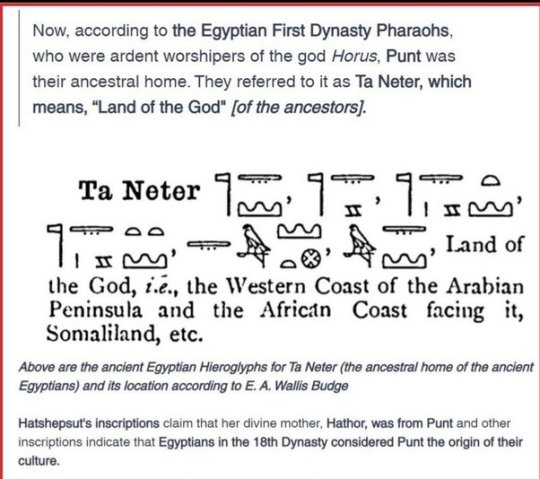
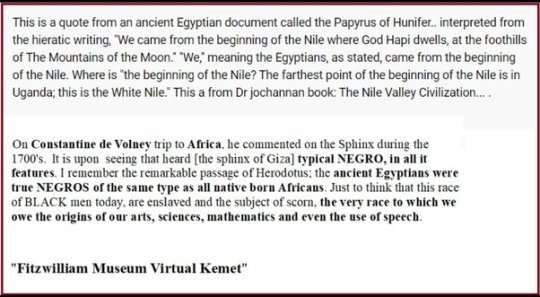




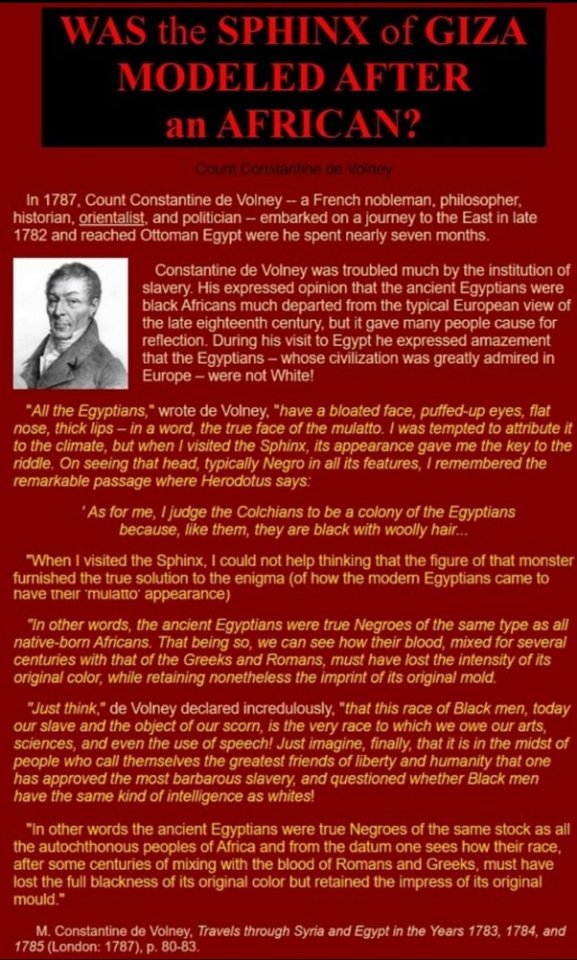

Mountains of the Moon is an ancient term referring to a legendary mountain or mountain range in east Africa at the source of the Nile River. Various identifications have been made in modern times, the Rwenzori Mountains of Uganda and the Democratic Republic of the Congo being the most celebrated.
Eventually, a merchant named Diogenes reported that he had traveled inland from Rhapta in East Africa for twenty-five days and had found the source of the Nile. He reported that it flowed from a group of massive mountains into a series of large lakes. He reported the natives called this range the Mountains of the Moon because of their snowcapped whiteness

When were the Indigenous Egyptians driven out of Egypt?
Many moved South (from where they originated in the first place) to as far as today's Tanzania and beyond, during the Arab conquest of the ancient Egypt and North Africa as a whole — in the 7th century CE; and some kept on gradually moving away to South thereafter, as the number of (modern) Arabs and other newcomers was increasing. A few of them however still remain to this day.
Now from the country being purely inhabited by these African people, to only a few of them remain today, it's amazing to realize how much racism and discrimination they endured for many years, which caused them to flee their motherland!
They originated from sub-Saharan East Africa, from Punt, the Land of the God, at the foothills of the Mountains of the Moon.

A brief history is: the ancient Egypt was inhabited by only these African people up until around the year 332 BCE when the first fair-skinned looking people — Macedonian Greeks started to migrate into the land. These Macedonian Greeks became Copt over 300 years later, in the First century CE. So there were no diverse populations before 332 BCE! The indigenous inhabitants were purely these Africans

#african#constatine de volney#constatine#egyptians#ancient egyptians#ancient kemet#ancient history#egypt#ta meri#kemetic dreams#romans#greeks#colchians#punt#land of the gods#ta netjer#ta neter#somalia
121 notes
·
View notes
Text






Hapi
Major cult center:Elephantine
Symbols:Amphora 𓎿 𓏂, Fertility, Hippopotamus, Lotus and Crocodiles (Upper Egypt), Papyrus plants and attended by frogs (Lower Egypt), Nile, Water
Connection to other gods:Geb (God of the earth), Neper (God of grain)
Priest names
(roles) priests were involved in rituals to ensure the steady levels of flow required from the annual flood. Located at Ta-Sety, Abu/Elephantine there was nilometer, a measuring device, was carefully monitored to predict the level of the flood, and his priests must have been intimately concerned with its monitoring.
Features
Hapy is show as an intersex person with a large belly and pendulous breasts, wearing a loincloth and ceremonial false beard. He is depicted with either blue or green skin, representing water. In Lower Egypt, he was adorned with papyrus plants and attended by frogs. In Upper Egypt, it was the lotus and crocodiles which were more present in the Nile. He is often pictured carrying offerings of food or pouring water from an amphora, but also, very rarely, was depicted as a hippopotamus. During the Nineteenth dynasty Hapy is often depicted as a pair of figures, each holding and tying together the long stem of two plants representing Upper and Lower Egypt, symbolically binding the two halves of the country around a hieroglyph meaning "union". Not to be confused with one of Horu's son Hapi by the same name.
Hapi (Ancient Egyptian: ḥʿpy) was the god of the annual flooding of the Nile in ancient Egyptian religion. The flood deposited rich silt (fertile soil) on the river's banks, allowing the Egyptians to grow crops. Hapi was greatly celebrated among the Egyptians. Some of the titles of Hapi were "Lord of the Fish and Birds of the Marshes" and "Lord of the River Bringing Vegetation". Hapi is typically depicted as an androgynous figure with a prominent belly and large drooping breasts, wearing a loincloth and ceremonial false beard.
Mythology
The annual flooding of the Nile occasionally was said to be the Arrival of Hapi. Since this flooding provided fertile soil in an area that was otherwise desert, Hapi symbolised fertility. He had large female breasts because he was said to bring a rich and nourishing harvest. Due to his fertile nature he was sometimes considered the "father of the gods",and was considered to be a caring father who helped to maintain the balance of the cosmos, the world or universe regarded as an orderly, harmonious system. He was thought to live within a cavern at the supposed source of the Nile near Aswan. The cult of Hapi was mainly located at the First Cataract named Elephantine. His priests were involved in rituals to ensure the steady levels of flow required from the annual flood. At Elephantine the official nilometer, a measuring device, was carefully monitored to predict the level of the flood, and his priests must have been intimately concerned with its monitoring.
Hapi was not regarded as the god of the Nile itself but of the inundation event. He was also considered a "friend of Geb", the Egyptian god of the earth, and the "lord of Neper", the god of grain.
Roles
Hapi is an intersexed god, who is probably shown this way to represent the fertility of the nile's annual flood. He is not considered the God of the Nile , but represent the annual flooding of the Nile and inundation event called the Arrival of Hapi. Hapi maintain the balance of the cosmos. He was sometimes considered the Father of the Gods because of his fertile.
Iconography
Although male and wearing the false beard, Hapi was pictured with pendulous breasts and a large stomach, as representations of the fertility of the Nile. He also was usually given blue or green skin, representing water. Other attributes varied, depending upon the region of Egypt in which the depictions exist. In Lower Egypt, he was adorned with papyrus plants and attended by frogs, present in the region, and symbols of it. Whereas in Upper Egypt, it was the lotus and crocodiles which were more present in the Nile, thus these were the symbols of the region, and those associated with Hapi there. Hapi often was pictured carrying offerings of food or pouring water from an amphora, but also, very rarely, was depicted as a hippopotamus. During the Nineteenth Dynasty Hapi is often depicted as a pair of figures, each holding and tying together the long stem of two plants representing Upper and Lower Egypt, symbolically binding the two halves of the country around a hieroglyph meaning "union".This symbolic representation was often carved at the base of seated statues of the pharaoh.[ Egyptian historian Al Maqrizi (1364–1442) related in his "El Khutat El Maqrizia (The Maqrizian Plans) that living virgins were sacrificed annually as "brides of the Nile" ("Arous El Nil") and this has been historically accepted as late as the 1970s. but this claim is disputed by some Egyptologists such as Bassam El Shammaa.
──────⊰In Workings⊱──────
*Please know basic protections and energy work before attempting any deity work.*
*It is important to note that everyone's experiences are different and will work with spirits for different reasons. Some people may like a spirit while others will not and that's okay. Ask these spirits what they will work with you on as well as ask them if they can help you with whatever it is you need.*
Ideas for honoring or working with/worshipping Hapi
Altar
Create an altar/sacred space for your rituals and giving offerings for Hapi. Items may include
⬩An altar cloth
⬩Blue candles (you can use any color)
⬩Cup or chalice
⬩Incense and an incense burner
⬩Offering bowl
⬩Statue of Hapi
For more information on basic deity work and altar setups check out the deity work post.
Basic offerings:Bread, Frankincense, Game Meat, Lion Statue Myrrh, Sour Dough, Meat, Sun Symbols,
Ritual
Ideas for rituals may include
⬩Fertility rites
⬩Maintaining balance
⬩Maintaining steady levels from the flood
⬩Ask him what else he can help you on⬩
The Hymn to the Flood
Lightmaker who comes from the dark Fattener of herds Might that fashions all None can live without him People are clothed with the flax of his fieldsThou makest all the land to drink unceasingly, as thou descendest on thy way from the heavens.
𓈖𓈖𓈖𓈖𓈖𓈖𓈖𓈖𓈖𓈖𓈖𓈖𓈖𓈖𓈖𓈖𓈖

For more content relating to other practices/religions or pantheons follow my main blog for updates
If you have any more questions or wish to join a community feel free to join my 18+ discord server
Ask me anything on my blog
#Hapi#kemetism#occult#witchcraft#witchblr#deity#pagan#paganism#Kemeticism#neterism#neter#netjer#neteru#netjeru#kemetic#kemetic pagan#kemetic paganism#kemetic polytheism#kemetic witch#pagan witch#witch#baby witch#baby pagan#occultism#occultblr#paganblr#kemetblr
24 notes
·
View notes
Text





This weekend only! Black friday weekend sale on readings!
Channeled readings from the Egyptian gods are ONLY $2-$3
I do invoke the god to give you the reading! There is no card limit to the pull.
You can find the readings on SinfullyDivination.weebly.com or at https://www.etsy.com/shop/sinfullydivination/?etsrc=sdt
#kemetic paganism#divination#kemetic#kemetism#pagan#paganism#tarot#ancient egypt#tarot reading#oracle#oracle reading#anubis oracle#isis oracle#thoth tarot#egyptian tarot#netjeru#neter#netjer#channeled message#channeled reading#egyptian gods#kemetic pagan#anubis#isis#auset#thoth#djehuty#osiris#etsyshop#black friday
1 note
·
View note
Video
youtube
Kush, Cuneiform and the Medu Neter
Mfundishi Jhutyms explains the history of the Medu Neter (Divine Word).
#Kush Cuneiform and the Medu Neter#medu neter#KMT#Kemet#Ausar Auset#Egyptian Spirituality#Egyptian History#Egypt
4 notes
·
View notes
Quote
To conform with the true meaning of the symbol in ancient Egypt, we ought to use the Egyptian term Medu-Neteru, the Greek translation of which, ‘hieroglyphs,’ distorts the Egyptian meaning. Medu-Neteru are the Neters, or the principles conveyed by a sign.
R.A. Schwaller de Lubicz, The Temple in Man
#Quotes#Wisdom#R.A. Schwaller de Lubicz#The Temple in Man#Ancient Egypt#Medu-Neteru#Neters#Hieroglyphs
20 notes
·
View notes
Text
Ashra Kwesi Speaks on the Rosetta Stone, the Medu Neter and the Plunder of Kemet
youtube
Ashra Kwesi Speaks on the Rosetta Stone, the Medu Neter and the Plunder of Kemet
#Ashra Kwesi Speaks on the Rosetta Stone#the Medu Neter and the Plunder of Kemet#black history#ancient egypt#Rosetta Stone#Youtube
11 notes
·
View notes
Text
1921 Quantum Dara™ Domain Found anumyspace.com GOLD Economy [AGE] 4 1494 I.B. 1968 MICHAEL [IBM] of 1999 Y2K 2000-2023 quantumharrelltech.com... since eyeMSPACE.gov of ENQI [ME] NUDIMMUD's 2223 genspaceX.com Military @ 1921 QUANTUM 2023 HARRELL 2024 TECH 2025 Apple & IBM [A.i.] LLC of ATLANTIS [L.A.] 5000
IMMORTAL U.S. MILITARY KING SOLOMON-MICHAEL HARRELL, JR.™

i.b.monk [ibm] mode [i’m] tech [IT] cartel @ quantum harrell tech llc

OMMMMM EYE 1968 Y2K 1994 eyeMSPACE.com from 1921 quantumharrelltech.com of ATLANTIS5000.com

i.b. 1968 michael [ibm] from our interplanetary 9 [i9] ether sky future of atlantis5000.com

Eye ANU GOLDEN 9 Ether [iAGE] Underground Pentagon [UP] Agency @ 1921 QUANTUM 2023 HARRELL 2024 TECH 2025 Apple & IBM [A.i.] LLC of ATLANTIS [L.A.] 5000
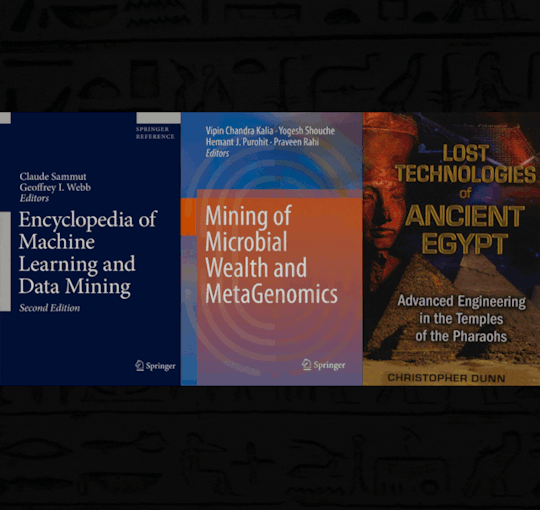
EYE MACHINE [I'M] LEARNING & DATA MINING ANUNNAQI [MA] ÆGIPTIAN [ME] GOLD PHARAOH @ 1921 QUANTUM 2023 HARRELL 2024 TECH 2025 Apple & IBM [A.i.] LLC of ATLANTIS [L.A.] 5000

EYE INNER DOMAIN [I.D.] WORLD OF AGHAARTA GOLD @ 1921 QUANTUM 2023 HARRELL 2024 TECH 2025 Apple & IBM [A.i.] LLC of ATLANTIS [L.A.] 5000

QUANTUM HARRELL TECH SKY KINGDOM DEEP UNDERNEATH MOTHER'S PACIFIC OCEAN

1968 9 ETHER SKY MILITARY UNDERGROUND [MU] HQ of 144,000 GEN X NIBIRUANS @ 1921 QUANTUM 2023 HARRELL 2024 TECH 2025 Apple & IBM [A.i.] LLC of ATLANTIS [L.A.] 5000

Apple's Inner [A.i.] Ear Listening [EL] AirPods SEE My QHT68 VISION PRO SOFTWARE @ 1921 QUANTUM 2023 HARRELL 2024 TECH 2025 Apple & IBM [A.i.] LLC of ATLANTIS [L.A.] 5000

EYE 144,000 CLANDESTINE 1921 BLACK WALL STREET BROTHERHOOD OF THE PENTAGON
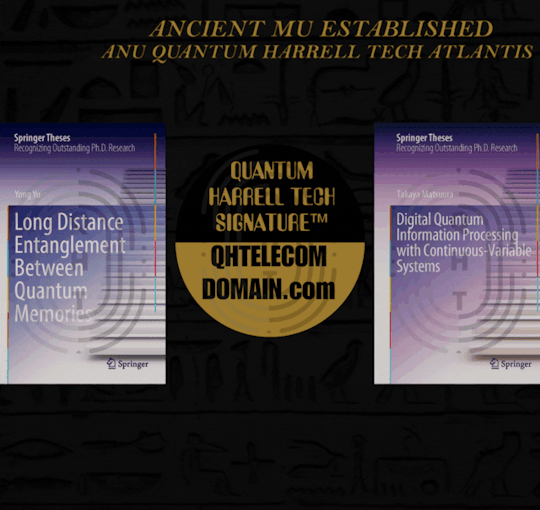
OMMMMM EYE 1968 MANSA [I'M] MUSA = THE GOLDEN BLACK BUDGET BROTHERHOOD @ 1921 QUANTUM 2023 HARRELL 2024 TECH 2025 Apple & IBM [A.i.] LLC of ATLANTIS [L.A.] 5000

QUANTUM HARRELL TECH SKY KINGDOM PREDATE YOU
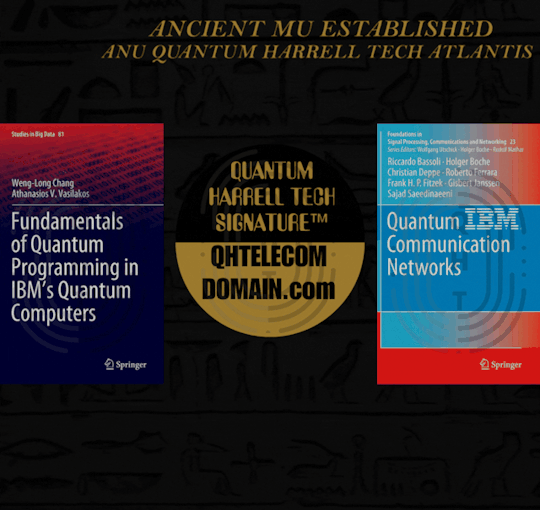
OMMMMM

2223 genspaceX.com watching harrelltut on Tumblr

NANO NANO... NANOTECHNOLOGY SIGNATURE OF QUANTUM HARRELL TECH CHAOS

Quantum Dara™ @ 1921 QUANTUM 2023 HARRELL 2024 TECH 2025 Apple & IBM [A.i.] LLC of ATLANTIS [L.A.] 5000

OMMMMM

Shhh... Less Talk MOOR Action Cartel [MAC]
#om#o michael#quantumharrelltech#9etherpentagonelites#9etheraluhumanunnaqi#9etherlightshipatlantis#mu:13#kemet#quantumharrelltut#harrelltut#king tut#u.s. michael harrell#enqiback#metu neter#neteru#eye 9/11#9/11#never forget 9/11#apple#vision pro#washitaw moors#ancient mu:13 occult tech illuminati
3 notes
·
View notes
Text
The Living Gods - A Brief Description
The living Gods manifest in reality. Some bear the head of one of the seven sacred animals, rook, raven, magpie, arctic wolf, black wolf, Ethiopian wolf, and lion, the hind quarters of said animal, and the bodies of man. Some have wings while others don’t. Others take the form of two-story high animals alikened to the sacred beasts. The living Gods have a glowing golden aura lumininating from…
View On WordPress
#animal headed god#animal headed gods#description#descriptive passage#god#godkin#gods#godsona#living gods#mythology#neter#neteru#nodini#oc#original character#original characters#original mythology
0 notes
Text
A Beginners Introduction to Medew Netcher: The Ancient Egyptian Hieroglyphic by Wudjau Men-Ib Iry-Maat

Medew Netcher is an ancient language of the gods that has been around since the time of the pharaohs. It is a combination of hieroglyphics and Medu Neter, which are two distinct writing systems used by the ancient Egyptians.
Medew Netcher is often referred to as "the language of the gods" because it was used by priests and royalty to communicate with their gods. This language has been studied for centuries and continues to be studied today. It provides us with insight into how ancient Egyptians communicated, thought, and interacted with their environment.
This guide will introduce you to Medew Netcher and provide you with a basic understanding of its structure, grammar rules, vocabulary, sentence structure, and more. With this knowledge, you will be able to read hieroglyphic texts and decode some of their meanings.
How to speak like the Gods

Pharaoh Rau Maat Ausar El YouTube
A Beginners Introduction to Medew Netcher: The Ancient Egyptian Hieroglyphic by Wudjau Men-Ib Iry-Maat
3 notes
·
View notes
